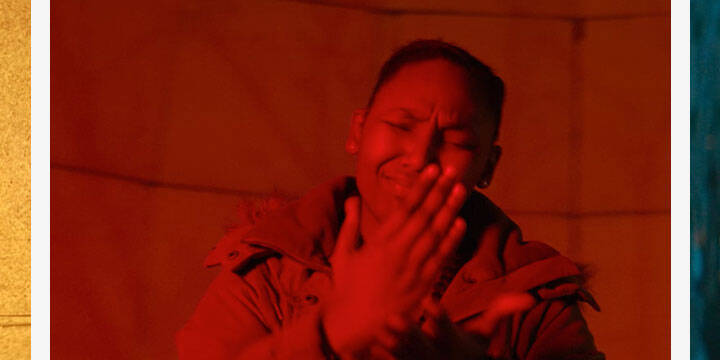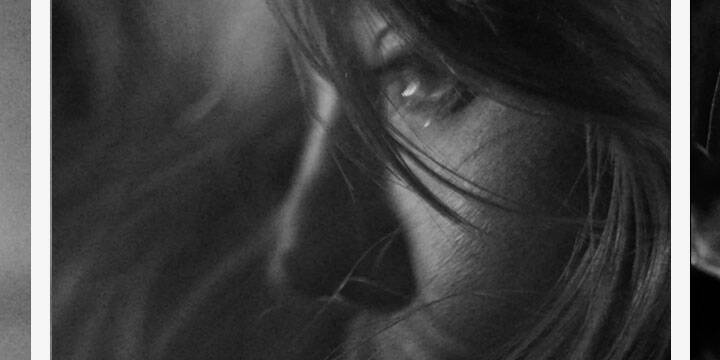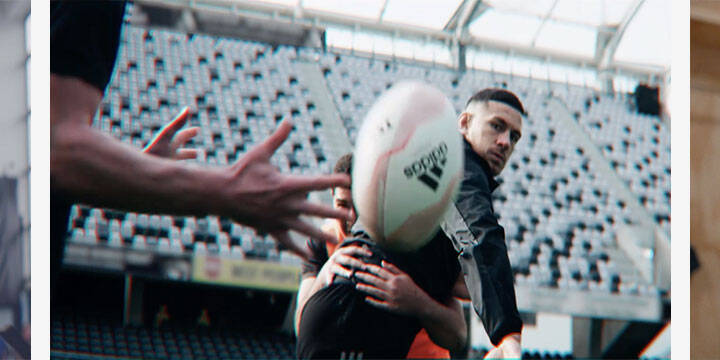Early in 2013 my company, Red Earth Studio, was asked by Skydance Productions and Mt Philo Films in the USA to supply crew and kit for the official America’s Cup film. Filming would take place over six weeks in San Fransisco and additional pickup shoots in New Zealand and the Isle of Wight.
We had also filmed the the previous Americas Cup film when it took place in 2009 in Valencia, Spain, so it was great to be back on board and this time against such an incredible backdrop as the San Fransisco Bay area.
The city had been preparing for the event for over a year. San Francisco sits in a vast natural bay. Along the waterfront are lots of protruding wharfs, a remnant of its fishing and sea trading days. Nowadays the wharfs have mostly been developed with trendy restaurants and offices, though some are still in a state of disrepair. Larry chose Pier 27 for the America’s Cup Event.
For the first time the Cup was to be broadcast live on US free-to-air TV. It was to be a showdown between current AC cup holder Oracle Team USA – owned by Larry Ellison, the 4th richest man in the world – and three contenders from New Zealand (Emirates), Italy (Luna Rossa) and Sweden (Artemis).
NBC was the host broadcaster and there were questions as to whether it would appeal to a broad audience. In the past the race was sailed off-shore making TV coverage and spectating difficult. For the first time in the cup’s history, all the sailing would take place within a bay. The start would be by the Golden Gate Bridge, heading over to Alcatraz, back to the bridge and straight down to the finish line by Pier 27. Depending on the wind, the race would be over in as little as thirty minutes. Perfect for television and the thousands of spectators that would line the shore and streets of San Francisco. You could watch it from pretty much anywhere in the city where there was a view of the water.
The Official Film was there to capture everything that the live TV feed couldn’t. Executive Producer David Ellison was in charge. He and his company Skydance are responsible for some of the biggest blockbusters of the last couple of years: Star Trek into Darkness, World War Z. He also happens to be Larry Ellison’s son.
The previous shoot in Valencia had been shot on Sony PDW800s; this time David wanted to step up the production values and achieve a more cinematic look, despite the run-and-gun nature of the shoot.
He originally wanted everything shot 6k on a RED Dragon but due to the delayed release of the camera this wasn’t an option. Myself and another DoP both chose the SONY F55 to shoot on while a third DoP preferred the RED Epic. Though I hadn’t used it, I’d heard good things about the F55 and decided that it would be ideal for this production. Another operator ran with the C300. So mixed formats all the way!
After some initial tests at 4k RAW, the post crew said that it was going to be too much, so this was abandoned in favour of 1080 across all cameras.
It was a real mix of cameras and codecs, but Paul Angell, our head DIT and his assistant Tom Goudsmit did a fantastic job of managing it all. In addition to all the cameras and formats above they were also taking in footage from two Cineflex cameras (recording ProRes on Cinedecks) and the live feed.
As always, when new cameras are thrown onto the market there’s a mix of excitement and trepidation. The marketing behind the F55 caught everyone’s attention, but once released it soon became apparent that the camera was released before it was ready. Despite the negative press I was still excited to be shooting on the it and couldn’t wait to see the results. My fly-away kit included Samyang prime lenses with EF to PL adaptor and two B4 lenses (HJ11 and HJ22) with an IBE HDx35 adaptor. I must say, the HDx35 is an absolute Godsend. With the speed of development today there is nothing worse than having to upgrade cameras and then watch your old lenses gathering dust. Our HJ lenses had spent a year on the shelf waiting for something as good as the HDx35 to come along to finally be able to use on the large sensor bodies. They’re a big investment, so it’s great to be able to use the HJ22 on those long shots without having to fork out another twenty thousand pounds or so on a new zoom lens.

It always takes a while to get to know a camera inside out and feel completely comfortable with it. I had done a bit of research before leaving and had spent a couple of hours at a London rental house to familiarise myself with the F55 and see if there was anything I should watch out for. A couple of hours is never enough and I was slightly apprehensive having read lukewarm reaction user reviews at the time to some missing functionalities. After testing though I was confident I could work around the these and that the camera was a good’un for the job.
On location things were a bit of a mixed bag. First the positives: I think the ergonomics of the F55 are really good. I would never have thought these cameras to be great at run-and-gun ob-doc style shooting, but it was brilliant. It was rigged with shoulder mount and handle and bars and weighed about the same as a PDW800. The controls are simple and I love this. It’s a clean, clear layout of buttons and controls, very well designed, athough there is a lag when going through the menu which will hopefully be fixed in future firmware releases. I like the side display and the power consumption is surprisingly low. Even on the most full-on shooting days I only ever used two PAG PL96 batteries. And to think I had brought eight batteries just in case! Sony’s OLED viewfinder is incredible, such a clean and sharp picture. The best I have worked with.
On the shoot, I mostly used the primes. Coming from a background of filming on ENG camera, I loved having to discipline myself by only using a prime lens to get all the shots. It meant that I had to be creative in my movement, finding a different angle, rather than standing in one position and zooming different frame sizes. I found the 35mm lens with a variable ND filter to be most useful (love this trick!).
The shoot consisted mainly of interviews with the sailors and colour around the event and the teams’ dock out areas as they prepared their yachts for the race. For the actual race, the production was covered by the OB, and by two Cineflexes, one on a chopper and one on a boat. So we spent a huge amount of time recceing the best locations around the city to film the race from its vantage points to highlight the grandness of this event. This is where the B4 lenses and the HDx35 came into their own, getting those long shots.
After a few days there were small things about the camera that started to annoy me, like the viewfinder cable. It protrudes out of the side of the camera together with the XLR inputs, which made it easy to knock into things like doors, people, walls etc. It would also come loose from the hooks that were meant to hold it in place on the viewfinder bracket. The viewfinder eyepiece was also frustrating, as the diopter kept loosening, calling for constant readjustment. (I had the same issue and solved it by wrapping a piece of elastic around the diopter ring. Ed)
At the time of filming the firmware was 1.3, an early release, and there were a few operational issues. For example there were no VU meters so we had to record audio on an external device using timecode to sync. We had a Lockit box but even that wasn’t the perfect solution; some days the camera would sync to it and then later it wouldn’t. We never did figure out why.
We were also getting nasty banding, particularly noticeable where I had clean background sky, blue or a grey mist. This caused something verging on panic amongst the whole technical crew, particularly after the ingested footage also manifested the same issue back in the edit. There seemed to be no reference to this on any of the literature and scouring the forums revealed no results either. I had to send some test shots back to London and while waiting on the results I dropped the F55 for a couple of days and switched to a C300.
A few nervous days later it was established that this was purely a playback issue. Playing the footage through a high grade Sony monitor, the image was lovely and crisp. It was all to do with the interpretation of the S-Log2 and the lack of an M-LUT in the camera (which has since been added in a later firmware release).
Once the camera issues were resolved, I could properly focus on the job at hand. As the days rolled into weeks, it became clear that the Kiwis were impeding us from filming them. Their PR guys kicked up a stink every time we were around, even in the mixed zone post-race. It was ridiculous. The producers were concerned that the film was missing a New Zealand angle especially as they were rising to the fore as major protagonists.
They eventually beat the Italians to set themselves up in the final as the sole challengers against Team Oracle who were having an absolute nightmare. This wasn’t in the script. Race after race, the kiwis were powering away, while the Americans failed to show up. It was getting embarrassing to the point the production crew were worried that Larry Ellison might want to pull the plug on the official film should a Kiwi victory be a white wash.
It was now imperative that we cover the New Zealand story so they asked a soundman, a producer and myself to hop over the Pacific down to New Zealand and capture some Kiwi reactions as well as youngsters learning to sail to highlight the popularity of the sport in the country.
What a lovely country New Zealand is. That was my first impression. It’s like a clean Australia, no offence to the Aussies there. It was actually quite relaxing being away from the event and capturing it from a completely different perspective and I felt really privileged to be filming general views around the beautiful coastal towns of Auckland. It was some absolutely stunning scenery and the pictures coming out of the F55 were gorgeous, particularly the sunrise over the city and the shots filming young yachties as they practise out at sea off pristine beaches.
Don’t you just love it when you get that perfect weather and light? There was a slight haze in the sky giving a glowing soft light, yet still sunny to give off that lovely flare in the lens.
Screen grab from the F55
I was sat on the side of a rib filming boats sail round us at 60fps, (shame it couldn’t do more at the time), these were some of my favourite shots from the shoot. It was cinematography porn. Although it was slightly precarious having to swap lenses while the sea was lashing against the boat and trying to protect the camera from any splash; but sometimes you gotta do what you gotta do to get that shot.
We returned back to San Francisco. The Kiwis had reached the dizzy heights of seven wins to Oracle’s one! They needed one more win and it was theirs. But then something remarkable happened. Oracle pulled out their wild card, the one and only Sir Ben Ainsley, Britain’s five time Olympic gold medallist and he somehow got the boat to winning ways. By hook and by crook, Oracle started clawing back the wins. 7-1 became 7-2. Then 7-3, 7-4, 7-5 and 7-6. Surely they weren’t about to overhaul such a huge lead? I think we were experiencing one of the most amazing comebacks in sporting history.
As it was, these catamarans they were sailing were something quite spectacular on water. This wasn’t sailing as we know it. This was taking sailing to another level never seen before and the crowds in the city gathered in their thousands to watch it.
As the suspense grew, so did the crowds and all along the coast of the city, on the end of wharfs, in tall buildings, in the hundreds of vantage points around San Francisco, everyone watched with baited breath as these two monsters on sails, hydro-foiled out of the water at break record speeds. It was really something to behold. I never thought a sport I had considered so boring could captivate me.
The live OB was incredible. It made fantastic television, and the Liveline graphics designed by Stan Honey, made it all make sense. The boats were rigged with countless minicams from all the possible angles and all transmitting live. It made you feel like you were sailing with those guys and it brought home how tough that sport was.
Finally the two teams were level at 7-7, setting up the big showdown deciding race. You couldn’t buy this kind of drama and the tension was incredible. Larry Ellison had gambled by bringing an elite sport for the rich to a new audience. He had a vision of making the sport accessible, exciting and he had succeeded in a big way. His ultimate reward was that his Oracle Team USA won the final race in one of the most exciting events I think I have ever witnessed.
To summarise the F55, I’d say my main comment is that if you’re expecting a ‘take it out of the box and shoot’ kind of camera, think twice. You might think it’s a direct upgrade from an F3, but it isn’t. It is a whole new workflow for starters. I work with FCP7 for example which isn’t supported so I’ve had to work out alternative routes to edit but that’s a whole other story… When all is said and done I do love this camera and I think it’ll just keep improving as Sony release updates.











